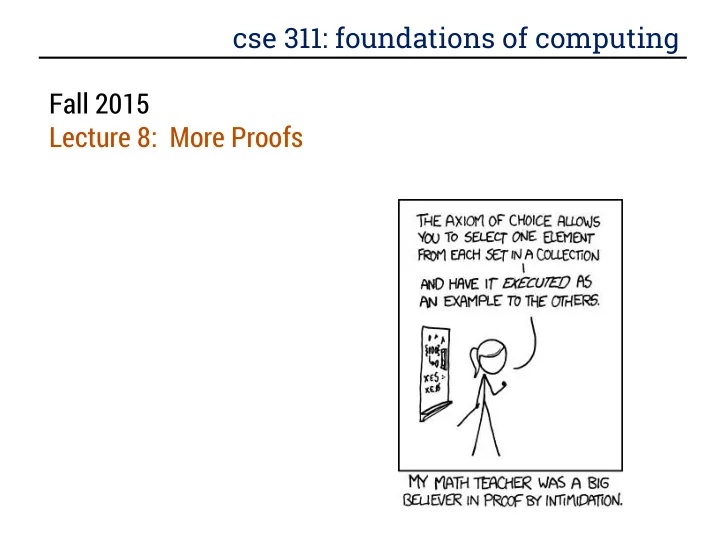

cse 311: foundations of computing Fall 2015 Lecture 8: More Proofs
review: proofs • Start with hypotheses and facts • Use rules of inference to extend set of facts • Result is proved when it is included in the set Statement Fact 2 Hypothesis 1 Fact 1 Statement Hypothesis 2 Result Hypothesis 3
review: inference rules for quantifiers x P(x) P(c) for some c ∴ P(a) for any a ∴ x P(x) x P(x) “ Let a be anything * ” ...P(a) ∴ P(c) for some special** c ∴ x P(x) * in the domain of P ** By special, we mean that c is a name for a value where P(c) is true. We can’t use anything else about that value, so c has to be a NEW variable!
proofs using quantifiers “ There exists an even prime number. ” First, we translate into predicate logic: x (Even(x) Prime(x)) 1. Even(2) Fact (math) 2. Prime(2) Fact (math) 3. Even(2) Prime(2) Intro : 1, 2 4. x (Even(x) Prime(x)) Intro : 3
even and odd Prove: “ The square of every even number is even. ” Formal proof of: x (Even(x) Even(x 2 )) Even(x) y (x=2y) Odd(x) y (x=2y+1) Domain: Integers
even and odd Prove: “ The square of every even number is even. ” Formal proof of: x (Even(x) Even(x 2 )) 1. Even(a) Assumption: a arbitrary integer 2. ∃ y (a = 2y) Definition of Even 3. a = 2c By elim : c special depends on a 4. a 2 = 4c 2 = 2(2c 2 ) Algebra 5. ∃ y (a 2 = 2y) By intro rule 6. Even(a 2 ) Definition of Even 7. Even(a) Even(a 2 ) Direct proof rule 8. x (Even(x) Even(x 2 )) By intro rule Even(x) y (x=2y) Odd(x) y (x=2y+1) Domain: Integers
even and odd Prove: “ The square of every odd number is odd ” English proof of: x (Odd(x) Odd(x 2 )) Let x be an odd number. Then x = 2k + 1 for some integer k (depending on x) Therefore x 2 = (2k+1) 2 = 4k 2 + 4k + 1 = 2(2k 2 +2k) + 1. Since 2k 2 + 2k is an integer, x 2 is odd. Even(x) y (x=2y) Odd(x) y (x=2y+1) Domain: Integers
counterexamples To disprove x P(x) find a counterexample: – some c such that P(c) – works because this implies x P(x) which is equivalent to x P(x)
proof by contrapositive: another strategy for implications If we assume q and derive p, then we have proven q p, which is the same as p q. 1. q Assumption ... 3. p 4. q p Direct Proof Rule 5. p q Contrapositive
proof by contradiction: one way to prove p If we assume p and derive False (a contradiction), then we have proved p. 1. p assumption ... 3. F 4. p F direct Proof rule 5. p F equivalence from 4 6. p equivalence from 5
even and odd Prove: “ No integer is both even and odd. ” English proof of: x (Even(x) Odd(x)) x (Even(x) Odd(x)) We proceed by contradiction: Let x be any integer and suppose that it is both even and odd. Then x=2k for some integer k and x=2m+1 for some integer m. Therefore 2k=2m+1 and hence k=m+½. But two integers cannot differ by ½ so this is a contradiction. So, no integer is both even an odd. Even(x) y (x=2y) Odd(x) y (x=2y+1) Domain: Integers
rational numbers • A real number x is rational iff there exist integers p and q with q 0 such that x=p/q. Rational(x) p q ((x=p/q) Integer(p) Integer(q) q 0) • Prove: If x and y are rational then xy is rational x y ((Rational(x) Rational(y)) Rational(xy)) Domain: Real numbers
rational numbers Rational(x) p q ((x=p/q) Integer(p) Integer(q) q 0) Prove: x y ((Rational(x) Rational(y)) Rational(xy)) Domain: Real numbers
rational numbers Rational(x) p q ((x=p/q) Integer(p) Integer(q) q 0) Prove: x y ((Rational(x) Rational(y)) Rational(xy)) Domain: Real numbers
rational numbers • A real number x is rational iff there exist integers p and q with q 0 such that x=p/q. Rational(x) p q ((x=p/q) Integer(p) Integer(q) q 0) You might try to prove: - If x and y are rational then x+y is rational - If x and y are rational (and 𝑧 ≠ 0 ) then x/y is rational Domain: Real numbers
proof by contradiction Prove that 2 is irrational.
proofs summary • Formal proofs follow simple well-defined rules and should be easy to check – In the same way that code should be easy to execute • English proofs correspond to those rules but are designed to be easier for humans to read – Easily checkable in principle • Simple proof strategies already do a lot – Later we will cover a specific strategy that applies to loops and recursion (mathematical induction)
one more proof Theorem: There exist two positive irrational numbers 𝑦 and 𝑧 such that 𝑦 𝑧 is rational. 𝜌 2 ? 𝑓 𝜌 2 ? 𝜒 𝜒 ?
Recommend
More recommend